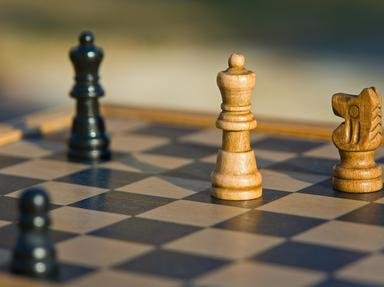Quiz Answer Key and Fun Facts
1. I explore the board, trying to find any means of escape. I come across a square labelled "d2". What piece will be placed here when we start the game?
2. "PLEASE TAKE THE POSITION OF THE WHITE KING. THE GAME WILL BEGIN IN THIRTY SECONDS," the voice tells me. I have forgotten which one, but there is one thing out of the following options that the king cannot do. Which one?
3. My opponent just moved a pawn forward two spaces in one go: "e7-e5". I thought pawns could only go forward one space per go. How did my opponent do that?
4. "Ng8-f6", the voice says after my opponent makes a move. What did he do in that move?
5. This game began with 1. e2-e3 e7-e5 2. f2-f4 e5xf4 3. Ng1-f3 Qd8-h4. Which of my (white) pieces can NOT move now?
6. My opponent moves his pawn forward to b1. "b2-b1Q" His pawn falls through a trapdoor and a queen replaces it. "Cheat," I shout, "unfair!" But what just happened is well within the rules. When can I replace one of my pawns with another piece (except a king or another pawn)?
7. "Bg6xh7" My queen falls through a trapdoor - she has been captured. Now there are only a few pieces left on the board. This means it is currently the ___. Fill in the blank.
8. I think the game is nearly over, but I don't know when the game ends. When, from these choices, does the game end?
9. One of my pawns just got promoted into a queen! Now I have a queen, a rook and a knight. If my opponent has two rooks, a bishop and two pawns, then who has the most valuable pieces?
10. More pieces have been captured. Black has only a king, and I (white) have a king and a castle, and I'm not sure if I can win with just a king and a castle.
It is impossible to win with which of the following combinations of piece against a lone king?
Source: Author
AdamM7
This quiz was reviewed by FunTrivia editor
WesleyCrusher before going online.
Any errors found in FunTrivia content are routinely corrected through our feedback system.

